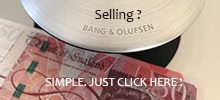Why Widescreen?

Stretching it out
The first widescreen Bang & Olufsen TV was the BeoVision Avant, released in 1996.
It has been followed by many other models - BeoVision 3, BeoVisions 4 & 5, the BeoVision 6 & 7, BeoCenter 6, and most recently, the striking 50" BeoVision 9. However, many Bang & Olufsen owners still use the MX range, which incorporates a 4:3 aspect screen.
The 4:3 format didn't gain recognition until 1936 when the BBC started its own 405-line TV broadcasts, curtailed by the Second World War two years later (see 'Vintage Bang & Olufsen products). Before this, the world's first TV broadcasts began life with only 30 lines per picture. Marconi's system - employing low-resolution representations, operated a vertically-scanned letter-box aspect ratio in order to allow the best match for head-and-shoulders views. The current trend towards widescreen - or 16:9 aspect ratios - began with the cinema.
When you visit the cinema you will probably see a film that has been filmed in Panavision 'Scope' where it has been filmed with a very wide lens and produces an image that is 2.35:1. What this really means is that an image filmed at 2.35:1 is 2.35 times wider than it is high.
However, the majority of televisions in use around the world are nearly square in shape (1.33:1) or, as they are sometimes referred to, as '4 x 3'. But we all know that you can't fit a rectangle into a square. Or can you? In order to overcome this problem the wide-aspect image is transmitted as a 'letterbox' image when it's transferred onto a DVD. This means that they shrink the entire image until it's small enough to fit inside the square television screen whereby you obtain the entire image as it was filmed and the director intended. However, the drawback with this is that you get black bands at the top and bottom of the screen where no image is being shown.
Apart from true movie buffs who enjoyed watching their films the way that the director originally intended, people soon complained that their films were too small and that a lot of the screen area was being wasted. So, in order to satisfy the general public who wanted the whole of the television picture filled, the TV companies decided to 'Pan & Scan' the image.
Pan & Scan
The method that has mostly replaced cropping and squeezing is panning and scanning. In this process, a video technician views the movie with its original aspect ratio and decides which television-sized chunk of the movie to show at any one time. Usually, this means focusing on the elements of the picture that are most important to the plot, which is obviously a subjective decision. If you have two characters at either end of a widescreen shot, for example, the pan-and-scan operator must decide which one to show.
The operator will probably show the one that is talking, or performing the more conspicuous action. A careful pan-and-scan operator will try to represent the different important aspects of a shot by 'cutting' between the two halves of the screen, so that what was originally one shot becomes multiple shots. The operator can also create a pan from one side of the picture to another (hence the name of the process). However, because the original film is 'cropped', this can result with up to 40 - 55% of the original image being discarded through the process!
Panning and scanning satisfied the majority of TV or videotape viewers. However, for the more discerning DVD viewer, 'cropped' movies was simply not an option with the letterbox format generally only used for Laserdisc and DVD collectors.
However, even with later widescreen TVs the letterbox format was still unacceptable to a lot of viewers in that a widescreen or '16 x 9' TV has only an aspect ratio of 1.78:1. Obviously, this is still not as wide as a cinema format of 2.35:1 and can still show (smaller) black letterboxed bars. In order to improve this still further, the image was vertically stretched in order to fill out the whole screen This process is known as an 'Anamorphic Widescreen'. With an anamorphic widescreen, the picture is stretched only in the horizontal plane. If it is a 1.78:1 anamorphic then it will, after horizontal expansion, fill up the whole screen (top to bottom, left to right). However, if it is a 1.85:1 or 2.35:1 anamorphic there will still be black bars above and below the horizontally stretched image.
The anamorphic process produces better pictures on a widescreen TV because there is more information recorded in the vertical plane (i.e. more lines) whereas a letterbox has fewer lines recorded (basically, letterbox image is not as tall as anamorphic image prior to stretching by widescreen TV).
Squeezing & Cropping
If a movie was filmed using an anamorphic lens, then the complete picture already exists in a 1.37:1 format and so can be shown full frame on a television without cutting much of the image. The problem, of course, is that this image is severely squeezed, so that circles appear as eggs and everyone's faces are unflatteringly elongated. Most viewers find this distracting to say the least, so this formatting option is not used very often. Some video producers did release movies this way when home video was just starting out, but nowadays the only time you're likely to see this is at the beginning of a movie, as a way of fitting wide opening credits onto the screen. The more popular option in recent years has been to letterbox the opening credit sequence.
Another method from the early days of home video is cropping. This term is sometimes used generally to describe cutting off part of the original theatrical picture, but it also refers to one specific formatting method. In this original cropping technique, the video formatter simply presents the middle part of the theatrical picture on video. Cropped movies frequently have bad cinematography and can actually be hard to follow. This is because the technique blindly ignores anything that happens on the side of the screen, playing the odds that most of the important action will appear in the middle of the screen, at least in part.
If a minor character only shows up on the far left side of a wide-aspect ratio shot, then he or she may not even show up in the cropped edition of the movie. A particularly frustrating scenario is where two characters in conversation stand on either side of the picture. The viewer sees the entire conversation with only the very edge of each person's face appearing on their screen and nothing but blank space taking up the rest of the picture! Fortunately, this technique has mostly fallen by the wayside, only to appear on your screens nowadays on older videotapes.
Letterbox
No matter how it was filmed, the best way to present a movie on video as it was originally created is to 'letterbox' it. This format presents the full, wide picture on the middle of the television screen, with black bars above and below it. This maintains the movie's original theatrical aspect ratio, so that you see everything the director intended you to see. Because they preserve the original cinematography of the movie, letterbox, or 'widescreen', videos and DVDs have become more and more popular in recent years. The format is particularly common on DVDs because their increased storage capacity can hold both a letterbox version and a full-frame version, a presentation that uses the entire television screen. Also, their increased picture quality helps counteract the loss of resolution caused by shrinking the movie picture.
The problem with letterboxing is that it shrinks the viewing area of the television screen, which, if you have a small set to begin with, can make it fairly difficult to see the film. For this reason, letterboxing is not the most popular formatting option. Most viewers are distracted by the black bars at the top and bottom of their screen more than they are bothered by the idea of not seeing the picture as it was originally filmed, so full-frame movie presentations are much more prevalent than letterbox presentations.
In the future, most people will own wider televisions which will make the translation from film to video much easier. However, as we have said, current widescreen televisions have only an aspect ratio of 16:9, which is fairly close to the 1.85:1 ratio often used for modern movies, but still not close enough! For most people this is close enough, but for the true DVD owner and videophile this is probably still not close enough. TV manufacturers therefore still have some way to go before everyone is happy!
Created: 9th January 2007
Modified: 13th April 2007
Author Notes:
Thanks to Matthew Russell for the model updates!


